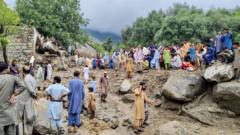In a tragic turn of events, at least 164 people have lost their lives in the last 24 hours due to severe monsoon flooding and landslides affecting various regions of Pakistan and Pakistan-administered Kashmir. Most fatalities, numbering 150, were reported by disaster management authorities in the mountainous region of Khyber Pakhtunkhwa in northern Pakistan, where at least 30 homes were destroyed and a helicopter crash during rescue operations claimed the lives of its five crew members.
The violence of the floods did not spare Pakistan-administered Kashmir either, where nine individuals died, and an additional five perished in the northern Gilgit-Baltistan region. Meteorologists are predicting heavy rains to persist until August 21, leading to a widespread heavy rain alert in northwestern areas of the country, which have been declared disaster zones.
Khyber Pakhtunkhwa Chief Minister Ali Amin Gadapur reported that the M-17 helicopter crashed while attempting to reach Bajaur, a region adjacent to Afghanistan, due to adverse weather conditions. Eyewitness accounts from Bajaur depicted a heart-wrenching scene, as a crowd gathered around an excavator digging through mud, while funeral prayers occurred nearby for the deceased, cloaked in blankets.
In the Indian-administered area of Kashmir, rescuers have been tirelessly working to recover bodies buried under mud and rubble after a severe flood swept through a Himalayan village, resulting in at least 60 fatalities and leaving many more unaccounted for.
The annual monsoon season, running from June to September, is responsible for delivering approximately 75% of South Asia's yearly precipitation. Unfortunately, landslides and flooding are not uncommon during this period, with this year's death toll surpassing 300. Punjab, home to nearly half of Pakistan's population, reported a staggering 73% increase in rainfall compared to the previous year, along with more deaths than those recorded in the entirety of last year's monsoon season.
Experts fear that climate change is exacerbating weather phenomena, resulting in more extreme and frequent extreme weather events, leaving the nation on high alert as it braces for more potential crises.



















